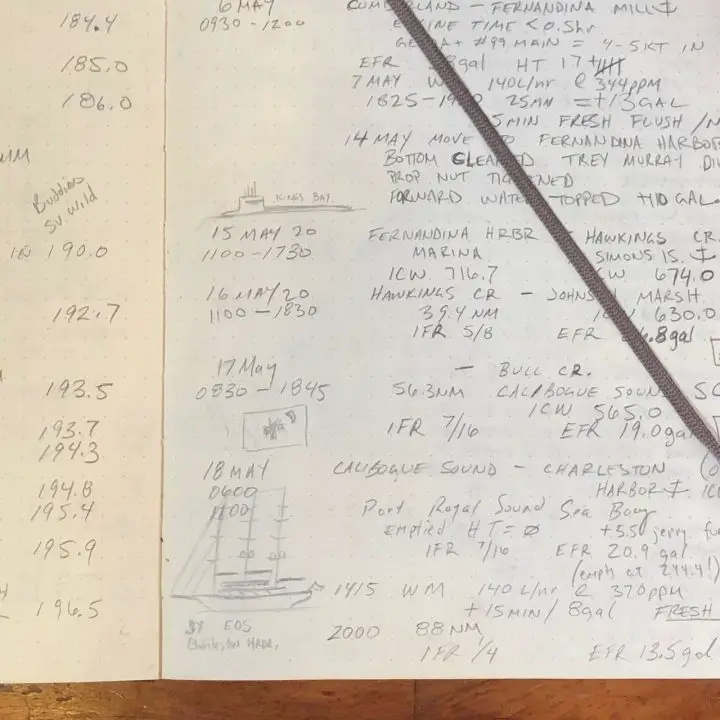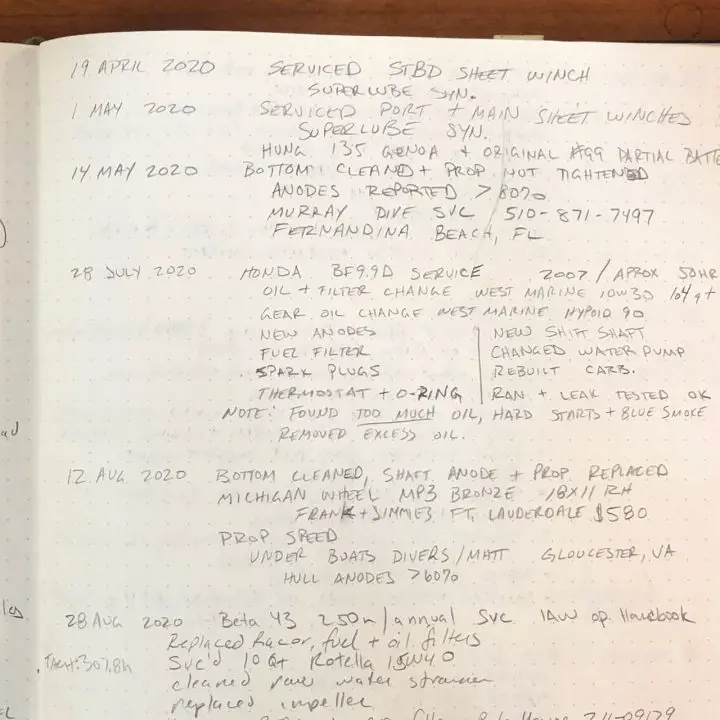Captains log, Stardate 5923.1. The sailing vessel Dulcinea is enroute to the Proxima Centari star cluster at 3.5 knots. If we could only get the spinnaker out to catch more of that solar wind! Uhura heard a Priority One Distress Signal on the VFR radio, but I told her to ignore it. That’s always how the trouble starts–in every single episode.
Even if you aren’t a Star Trek fan, the “captain’s log” is inextricably linked to the show. After all, it has been used as a narrative device to introduce hundreds of episodes.
But the sail logbook is not just a fictional creation for television. Instead, it’s a throwback to real-world history and naval exploration. Captains on the high seas have been keeping a ships log book for centuries. It’s the official record of the voyage and a primary part of the vessel’s navigational record.
But here you are, not in the 17th or 24th century. You’re stuck in the middle–in the 21st century – wondering how a sailing logbook could help you on your little boat. Here’s a look at what they are and why one deserves a place on every modern cruising vessel.

Table of Contents
- What is a Sailing Log?
- A Brief History of the Ship’s Log Book
- Why Should You Keep a Boat Captain’s Log Book?
- Types of Marine Logbooks
- Why Should Cruisers Keep a Detailed Ships Log?
- Commercially-Available Ship Log Book Options
- Make Your Own Boat Log Book
- Sailing Logbooks Aren’t Just for the Pros
- Sailing Log Book FAQs
What is a Sailing Log?
You can think of a logbook as a diary of sorts. It can be used to record any pertinent facts related to the voyage that you might want to remember later.
On a ship, the logbook keeps everyone on the same page. The officer coming on watch can review what happened during the last few hours and add notes so the next watch officer will have the same.
The log is also an official record of the voyage. If a port or customs agent wants proof of where the vessel has been, the log should provide that proof. To that end, it is an official legal document and is treated as such by the crew. Therefore, tampering with a ship’s logbook is a serious offense.
The logbook is still an official document kept on the bridge of big ships, but that level of officialdom doesn’t usually trickle down to small recreational vessels. There’s no requirement for small boats to keep a logbook, so those that do it do so for a personal reason.
A Brief History of the Ship’s Log Book
Logbooks are some of the best records historians have to study certain periods in time. Being an official record maintained by a professional crew, it accurately recorded the weather conditions and events at specific times. In some ways, they are like old newspapers from the high seas. Usually dull, but sometimes not.
Sailing Logs for Navigation with Ship’s Speed and Course
The logbook as used for navigation was updated hourly by the watch officers. The captain or navigator would take a noon sighting from the sun every day. This was the first step in producing a fix of the ship’s position with some fancy math. This would be the start of a new page in the log.
Throughout the rest of the day, the officers used the log to record the course and speed of the ship. From these, the navigator could estimate the ship’s position based on the noon sun sight and the observed course and speed using a process called dead reckoning.
Log keeping is still used today on merchant ships and naval military vessels. But many recreational boaters keep them, too. GPS provides many of the navigational functions these days, but it’s still essential to have an official record of events on board.

Why Should You Keep a Boat Captain’s Log Book?
Logbooks are not limited to boats or sailing.
Pilots keep logbooks as legal records of the hours they have flown. A pilot will keep their logbooks from their first flight as a student until their last fighter jet sortie or airline route is flown before retirement. During training, the logbook is required and proves to the FAA that the pilot did indeed complete the required training.
Once flying as a private or commercial pilot, the logbook proves that the pilot is current. The FAA requires a certain amount of flying to be done recently to carry passengers, and a pilot’s logbook proves whether or not this has been accomplished.
Just like boaters, however, most pilots log every flight hour. They need a record to apply for jobs or get insurance. Plus, it’s fun to look over those logbooks years later and remember certain flights.
Types of Marine Logbooks
Training Records and Logs
If you’re going to school or working with an instructor captain to learn your boat, you’ll want to keep a logbook to prove what you’ve learned. You’ll get a certificate of completion when you’re done with the training, but you’ll also want a record of each trip or each passage.
The American Sailing Association (ASA) is one of the biggest training organizations in the US for sailors. Many are familiar with the small ASA logbook you get when you enroll in your first class. That ASA log book is part of the course, but the hope is that you’ll keep using it for years afterward.
Professional Logbooks
You might want to keep a logbook for professional reasons. For example, this applies if you one day want to get your captain (master’s) license through the Coast Guard or any other maritime organization.
The Coast Guard requires you to submit a standard form of your sea service time. This form divides up the number of days you’ve spent on the water based on where you were (inland, near-coastal, or ocean). For example, to qualify for an OUPV license (Operator of Uninspected Passenger Vessels, or “six-pack” captains license), you need to log 360 days of sea service, 90 of which must have been in the last calendar year.
The Coast Guard forms are designed for working mariners more than private boat owners. Regardless, so long as you can prove that you owned the boat in question, you can log your time. Putting it down on the Coast Guard form just requires some time to divide up the times based on location and vessel.
Once you have a credential from the Coast Guard, you must log hours every year to keep it current. Licenses expire after five years, and the renewal requires filing the same paperwork again to show your recent experience.
Personal Logbooks
Not everyone wants to get professional credentials, of course. But even if you’re just keeping track of things for your own purposes, a boat captain logbook might still come in handy.
If you’re keeping a logbook for personal reasons, you can make anything of it you like. Draw pictures, keep a diary or make it only maintenance-related. Whatever you’d like to remember for later, a logbook is an easy way to do it.
Cruising Boat Logbooks
If you’re setting out on a big trip, casting off the dock lines, and sailing for the horizon, then you have a few more reasons why you ought to keep a logbook.
A watch log is a logbook kept that is updated at the end of every watch. Different skippers keep different watch schedules, but the idea is always the same. The boat sails all night, 24 hours per day, and the person on watch changes every few hours, so they are refreshed and get enough sleep.
The watch log provides a place for the person on watch to pass on any notes or important details to the person coming to relieve them.
At the most basic level, a cruising log helps you remember the places you when and the people you met. You might find yourself noting towns and anchorages that you’d like to spend more time in in the future. Or you might make notes of details that aren’t in the cruising guides, like the best times to cross inlets for slack tide or sandbars to avoid next time.
Maintenance Logbooks
In the aviation world, the pilots have logbooks, and the airplanes have logbooks. The airplane logbooks are for maintenance, to track the plane’s history from when it left the factory. The system is strict for safety reasons. The FAA sets a high standard for the maintenance of an airplane–one of the reasons that flying is as safe as it is.
As a buyer, buying an airplane comes with a lot more peace of mind than buying a boat does. Since the logbooks must convey with the sale of the plane, you know everything that has ever happened to that airplane. You should be able to see every oil change, tire change, and repair that it has ever had.
There are no regulations requiring such a thing on a boat, but it’s a handy thing to have, regardless. At the very least, you can track regular maintenance items like oil changes and anode replacements to ensure you don’t let anything go too long.
Why Should Cruisers Keep a Detailed Ships Log?
As you can tell from the list above, there are many reasons to keep a logbook. But here are a few more reasons that I’ve found it handy to do so after years of cruising.
Track Passages and Sea Time for Insurance
Every year, your insurance company may ask for an updated record of your experience. If your company doesn’t, they certainly will the next time you go shopping for insurance. They’ll want to know how many days you’ve been offshore or how many days you’ve spent boating. Every company has a slightly different record sheet, but many times they’re pretty detailed.
Sea Service Record for Coast Guard
After years of boating, my wife and I wound up getting our Coast Guard Master’s Licenses (captain’s licenses). We weren’t great about keeping tidy logbooks, so piecing together the hours for the licenses was a significant undertaking. We had to look through old records and photographs to piece together trips and how long they were.
Even if you don’t think you’ll want to get a professional license today, we never know what the future holds. If you’re getting experience on the water, there’s no reason not to keep a simple logbook and start tracking it.
FCC Radio Log
Ironically, there is one legal requirement that most recreational boaters are unaware of. As the holder of an FCC radio station license, you are supposed to keep a log of every other station you make contact with. It’s a pretty old rule, but a daily ship’s log makes an excellent place to do it.
Boat Condition Log Entries
There are all sorts of notes about the boat itself that you’ll find handy to have.
For example, you could use your logbook to track consumable items. If you carefully log how much fuel you use on each trip. That can provide an estimate of how much remains. Unfortunately, many boats have poor-functioning gauges.
Here’s another thing to think about. A few recent local laws have mandated that boaters record their sewage pump-outs. This way, if a boat is boarded by law enforcement, the skipper can prove that they are not dumping overboard. A maintenance log is a perfect place to do this. Two places that I know this to be the case are in the Florida Keys and the state of Georgia, although there are probably others.
On long passages with a lot going on, a logbook can also provide a record for the skipper. If the person on night watch notices that there is a little bit of chafe on a line, a problem with the chartplotter, or a thousand other little things that might go wrong, they can note it in the logbook. Then, the skipper will know what they need to attend to when they get to port.
Track and Keep Maintenance Tasks Up to Date
Logbooks also provide a place for you to track and keep routine maintenance in one place. Oil changes, rigging inspections, bottom cleanings, and whatever else you want to track can be kept in one place.
Increase the Value of Your Vessel
It’s worth noting that doing all of this work proves you keep your vessel in tip-top shape. And that means that your boat will fetch a higher price when you go to sell it. If you can prove that you have religiously changed the oil every 50 hours and tended to every problem promptly, a detailed logbook will make the buyer feel pretty good about buying your boat.
Travel Log and Memories for Prosteriety
Traveling is all about the experience and the adventure. Some cruisers write their adventures in a blog, video channel, or travel log. This starts with a detailed logbook because if you get behind in your writing or videos, the logbook can help you remember the details and the order of events.
Even if you don’t publish it all later, it’s still worth having. When I think back on past boats I have owned, I often wish I had kept better logs. And now that I do, I love flipping through the pages and reliving some of those adventures.
Guest Book
Finally, a logbook is a fun place to keep a log of the people you meet and have aboard. You can make the notes yourself or let them leave little notes for future reference.
Commercially-Available Ship Log Book Options
If you want to get started fast, plenty of blank sailing log books are available to purchase. These are generic books of varying quality that have printed pages specifically for tracking boat stuff. Some are geared toward weekenders, some for long-range cruisers, and others for only maintenance items.
The Boat Galley Ships Log
For the cruising boater out there, you probably can’t find a better option than The Boat Galley’s Ship’s Log. This 8-by-10 inch spiral-bound volume includes tabbed sections for all the relevant items. In addition, there are plenty of little touches that will assure you that an experienced boater designed it. For example, the cover is waterproof, and the binding allows it to lay flat on your chart table.
Here are just a few of the boat log book template pages you’ll find in The Boat Galley’s logbook.
- Predeparture checklists
- Watch log
- Cruising log
- Spare parts lists
- Inventory
- Maintenance schedules
- Maintenance log sheets
- Fluid tracking (oil changes, water fills, pump outs, etc.)
- Five Logbooks In One: Ship’s Log, Cruising Log, Vessel Inventory, Fluid Changes & Fills, Maintenance, Repairs & Upgrades plus a Quick Reference section in an 8 x 10 book - large enough to comfortably write in but still small enough to store conveniently
Prices pulled from the Amazon Product Advertising API on:
Product prices and availability are accurate as of the date/time indicated and are subject to change. Any price and availability information displayed on [relevant Amazon Site(s), as applicable] at the time of purchase will apply to the purchase of this product.
Direct Boater Logbooks
Direct 2 Boater sells a selection of simple bound logbooks. In addition, they have separate ship and maintenance logbooks. Each has 100 pages and can be purchased bundled or individually.
- ⛵ SHIP’S LOG FEATURES lots of space to track Vessel and Excursions using a Diary Format to track trips while underway
Prices pulled from the Amazon Product Advertising API on:
Product prices and availability are accurate as of the date/time indicated and are subject to change. Any price and availability information displayed on [relevant Amazon Site(s), as applicable] at the time of purchase will apply to the purchase of this product.
BookFactory Captain’s Log
This simple bound book is a great value. It measures 11-by-8 and has 100 pages. The cover features a beautiful full-color chart. It includes the standard lined page for daily log entries, along with plenty of space for maintenance and other notes.
- Wire-O (White) Full Color Cover with Front and Back TransLux
Prices pulled from the Amazon Product Advertising API on:
Product prices and availability are accurate as of the date/time indicated and are subject to change. Any price and availability information displayed on [relevant Amazon Site(s), as applicable] at the time of purchase will apply to the purchase of this product.
Graphic Image Leather Ship’s Log
This logbook is one of the most expensive and one of the most beautiful. In addition to the standard lined daily logs, it includes full-color maps of the US and international destination coastlines. So you could mark your stops or show the courses you plotted. It has 162 pages.
Prices pulled from the Amazon Product Advertising API on:
Product prices and availability are accurate as of the date/time indicated and are subject to change. Any price and availability information displayed on [relevant Amazon Site(s), as applicable] at the time of purchase will apply to the purchase of this product.
Weems & Plath Logbooks
Weems and Plath is a trusted name in the boating world. They make an assortment of vital tools that fill your navigation table, from plotters and dividers to clocks and lamps. Their logbooks are spiral bound and measure about 8.5 by 11.5 inches.
The Ship’s Log includes lined pages for daily entries, a guest register, and pages for specifications and serial numbers. The Cruising Log has more lined blank pages for more detailed notes. Finally, the Maintenance Log includes all the items you’d expect–oil changes, maintenance, repairs, etc.
Prices pulled from the Amazon Product Advertising API on:
Product prices and availability are accurate as of the date/time indicated and are subject to change. Any price and availability information displayed on [relevant Amazon Site(s), as applicable] at the time of purchase will apply to the purchase of this product.
Prices pulled from the Amazon Product Advertising API on:
Product prices and availability are accurate as of the date/time indicated and are subject to change. Any price and availability information displayed on [relevant Amazon Site(s), as applicable] at the time of purchase will apply to the purchase of this product.
Make Your Own Boat Log Book
Since there’s no legal standard for what the logbook on a recreational vessel looks like, there are also no limits. Every sailor has a unique set of goals for their logbook, just like they have a unique set of goals when taking their boat out on a mission.
Some are just having fun for a day on the lake, while others are working their way around the globe. Chances are, the logbooks that these two sailors keep will look very different. Any commercial logbook you find is bound to have some pages you will have no use for and some other pages you wish it had.

I enjoy flipping through Dulcinea’s log and remembering what I have done since I became the owner and full-time caretaker of Dulcinea. My logbook is entirely my own and grows with me.
For example, internet cellular connections in remote areas became very important when we started working from the boat. So I started recording speed and signal test results in the logbook. When I wonder, when was the last time I refilled the propane, and how long does each tank last? I can look because that’s precisely the seemingly useless yet valuable data I put in there.
The Notebook
I wanted my log to have a traditional look and feel to match my traditional little sailboat. So with that in mind, a plastic or modern digital logbook made no sense. I also like the tactile feel of writing on a blank page of paper, not to mention changing it up and adding different details later on.
To this end, I went with a classic extra-large Moleskin notebook. There’s nothing marine-rated about it–it’s not waterproof and has no notable boat features. I do greatly appreciate the loose-papers pocket on the back cover, however. This is where I keep small and vital documents, like my Coast Guard documentation certificate and state registration.
- HARDCOVER RULED NOTEBOOK: The original portable device, this iconic portable hardcover notebook is just waiting to be filled with your ideas. It features ruled ivory-colored 70 g/m² acid-free paper
Prices pulled from the Amazon Product Advertising API on:
Product prices and availability are accurate as of the date/time indicated and are subject to change. Any price and availability information displayed on [relevant Amazon Site(s), as applicable] at the time of purchase will apply to the purchase of this product.
If you wanted a similar logbook with a diary feel, you might also try something like this leather writing journal. I worry about leather on a boat as it’s prone to mold and general boat funk, but if you keep it safe in a dry bag, it would make a beautiful keepsake.
- ✅ HIGH QUALITY VINTAGE JOURNAL - Durable & Elegant man-made leather cover great for travel or outdoor adventure. The sturdy design ensures your journal will be well protected and have increased longetivity. Sea life notebooks are unique gift for any ocean loving friends - a special keepsake for your thoughts, plans & ideas.
Prices pulled from the Amazon Product Advertising API on:
Product prices and availability are accurate as of the date/time indicated and are subject to change. Any price and availability information displayed on [relevant Amazon Site(s), as applicable] at the time of purchase will apply to the purchase of this product.
Sections In My Logbook
With a blank notebook, you can pick and choose what you want to include in your logbook. You could divide what I have done into multiple books or combine it with a digital supplement.
The point is to make your logbook unique and fun. The more personal and meaningful it is to you, the more likely you will update it regularly.
I used small plastic flags to break the notebook into sections. I estimated how many pages I wanted for each section. Here are the areas in my logbook.
- Inside front cover notes
- Cruising logbook
- Guest log
- Maintenance log
- Diagrams, notes, and system settings
Inside Front Cover
I skipped a few pages before I started the actual daily logs. I’m glad I did because I wound up using this space for some important notes.
I have some critical notes about the boat and our contact information right on the inside. I also sketched in a make-shift compass deviation card for my reference since our boat didn’t come with one.
Next, I have a page dedicated to things that expire. I can open this page and see when I need to take action. I have that divided up between paperwork and safety equipment.
Paperwork
- Coast Guard Certificate of Documentation (COD), expires every two years
- State registration, expires every three years (depends on state)
- Dinghy state registration, expires every three years
- US Customs entry decal (DTOPS), expires annually
- NOAA EPIRB registration, expries every two years
Safety Equipment
- EPIRB batteries, date stated on EPIRB
- Liferaft servicing and packing, usually required every one to three years
- Flare kit, expire every one to three years
- Rescue strobe batteries, replace annually
- PFD rearming kits, expire on date printed on inflator valves
Finally, I have a page dedicated to tracking the essential details for all of the onboard equipment. I have the date purchased, dealer, serial number, and anything else important listed.
The Actual Cruising Logbook
The majority of the book I have dedicated to trip logs. I don’t make it a page per day, and I’m not even consistent with how I log passages. I add a line every time I think of something to say!
At a minimum, every day the boat moves gets an entry. I try to record the date, departure and arrival locations and times, miles covered and average speed, and finally, the engine times recorded.
One of the most important things I record in the logbook section is the state of my fuel tank. I have a reliable fuel gauge installed now, but many boats do not.
Every time I get a fill-up, I record it on that day’s line. Every time I use the engine, I calculate the new estimated fuel level. The next time I get a fill-up, I check my engine’s fuel use in gallons per hour (GPH) and record that.
If the boat hasn’t moved, but something noteworthy happens–like we got a pump-out–then that gets a line item with the date.
I like to sketch and doodle, too. When traveling and entering the waters of a new state or country, I like to make a little drawing of the state’s flag in the margin. I add a little anchor next to spots to indicate nights at anchor versus docks. I’ve even sketched identifiable vessels we’ve passed or seen while enroute.
I also include pertinent notes about sailing conditions and some about the people or places we see along the way. And, of course, I make a note of what breaks and needs to be fixed later! Finally, here’s a ship log book sample from my captain’s log. It might look like gibberish to most people, but the doodles remind me how excited I was to see a nuclear Navy sub in Georgia and the Sailing Yacht EOS at anchor in Charleston Harbor.

Guest Log
Next, I have a few pages set aside for guests to make their mark. We don’t often have guests aboard, but I think it’s a fun memory to see what others want to put down about their time aboard.
Maintenance Logbook
I set aside the rear third of the notebook for a maintenance log. Then, just like my cruising log, I write a new line item for exciting events or chores that have been accomplished.
It’s this section that I consider a rolling tally of the boat’s status. I can flip to these pages and see when I last changed the engine oil, scrubbed the bottom, or changed the anodes.

Diagrams, Notes, and System Settings
I left the final few pages of the logbook for notes about the boat and her systems. This was helpful right after I bought the boat, and I was still getting to know her.
I made a rudimentary sketch for the plumbing and another for the electrical system. These helped me figure out details like through-hull locations and sizes. The electric schematic narrowed down all the electrical devices onboard and how much power each used.
Lastly, there are a few notes about some boring details I have come across that I know I’ll want later. For example, I have a diagram of all of the electrical wires that come out of the base of the mast and what they go to. I also have notes on exactly what settings I should put into my battery charger for my house batteries to get the right juice.
Sailing Logbooks Aren’t Just for the Pros
The most important takeaway is that a sailing log can take any form you want it to take. Unless you are one of the lucky few who work as a Navy officer or a Merchant Mariner, logbooks can be as personalized and colorful as you like.
Sailing Log Book FAQs
How do you make a sailing log?
Unless you’re working professionally or in a sailing class, there are no strict requirements for keeping a sailing logbook. It’s still a great idea to keep one, however. You can make it any way you like. There are dozens of options available online to start with as a template, or you can make your own with a generic notebook.
You can record any details you like. At a minimum, make a new line for every trip. Usually, people record the date and time, departure and destination, engine hours ran, fuel used, weather and sea conditions, and any passengers or notes.
Why do captains keep a log?
In the old days, the captain’s log was an official record of the ship’s position for navigation. It tracked the ship’s precise position every day at noon and then its course and speed for the next 24 hours. Using dead reckoning, the navigator could find the ship’s position any time of day from the log.
Today, captains keep log books for different reasons. On most recreational boats, they are kept like travel diaries of the journey. Professional mariners, however, still track their time at sea to prove their experience.











